Mapping Green Infrastructure Based on Multifunctional Ecosystem Services: A Sustainable Planning Framework for Utah’s Wasatch Front
Abstract
1. Introduction
1.1. Green Infrastructure as a Framework for Multifunctional Ecosystem Service Analysis
1.2. Multifunctional Landscapes and Multicriteria Analysis
- Collect, analyze, and review data to synthesize a set of interrelated sustainable landscape planning goals based on ecosystem services;
- Provide a framework to evaluate multifunctional landscapes using MCE which evaluates multiple ecosystem services based on a range of stakeholder values;
- Model the results in GIS based on green infrastructure components.
2. Materials and Methods
2.1. Study Area
2.2. Criteria Weighting and Ranking
3. Results
3.1. Ecosystem Services
3.2. Green Infrastructure Typologies and Landscape Classifications
3.3. Green Infrastructure Mapping Results
4. Discussion
4.1. Challenges and Opportunities for the Integration of Ecosystems Services and Green Infrastructure in Policy and Planning
- Areas of overlap between the community GI and the recreational GI to illustrate areas where accessibility may be lacking;
- Areas of overlap between the working land GI and ecological GI to illustrate zones where suitable agricultural and grazing practices should be employed to simultaneously support working lands productivity and maintain and enhance ecosystem health and integrity.
- Soils maps, particularly those within developed areas (not agricultural zones) to illustrate areas that may be appropriate for urban farming or urban forest expansion;
- Areas of overlap with land ownership, particularly private lands, where specific stewardship incentives can be prioritized;
- Areas of overlap between the ecological and hydrological GI and natural hazards to illustrate areas that should be prioritized for conservation due to a lack of suitability for development.
4.2. Innovative Ecosystem Services Mapping within a Green Infrastructure Approach for Sustainable Development
5. Conclusions
Supplementary Materials
Funding
Institutional Review Board Statement
Informed Consent Statement
Data Availability Statement
Acknowledgments
Conflicts of Interest
Abbreviations
| ES | Ecosystem services |
| GI | Green infrastructure |
| MCE | Multicriteria evaluation |
| TAC | Technical advisory committee |
References
- Scholes, R.J.; Reyers, B.; Biggs, R.; Spierenburg, M.J.; Duriappah, A. Multi-scale and cross-scale assessments of social–ecological systems and their ecosystem services. Curr. Opin. Environ. Sustain. 2013, 5, 16–25. [Google Scholar] [CrossRef]
- Ritchie, H.; Roser, M. Urbanization. Available online: https://ourworldindata.org/urbanization (accessed on 10 December 2018).
- UN-Habitat. World Cities Report 2016: Urbanization and Development: Emerging Futures. Available online: https://unhabitat.org/world-cities-report (accessed on 10 December 2016).
- Alberti, M. Maintaining ecological integrity and sustaining ecosystem function in urban areas. Curr. Opin. Environ. Sustain. 2010, 2, 178–184. [Google Scholar] [CrossRef]
- Pauleit, S.; Hansen, R.; Rall, E.L.; Zölch, T.; Andersson, E.; Luz, A.C.; Szaraz, L.; Tosics, I.; Vierikko, K. Urban landscapes and green infrastructure. In Oxford Research Encyclopedia of Environmental Science; Oxford University Press: Oxford, UK, 2017. [Google Scholar]
- Qian, Y.; Zhou, W.; Pickett, S.T.; Yu, W.; Xiong, D.; Wang, W.; Jing, C. Integrating structure and function: Mapping the hierarchical spatial heterogeneity of urban landscapes. Ecol. Process. 2020, 9, 1–11. [Google Scholar]
- Swyngedouw, E.; Heynen, N. Urban Political Ecology, Justice and the Politics of Scale. Antipode. 2003, 35, 898–918. [Google Scholar]
- De Groot, R.S.; Wilson, M.A.; Boumans, R.M. A typology for the classification, description and valuation of ecosystem functions, goods and services. Ecol. Econ. 2002, 41, 393–408. [Google Scholar] [CrossRef]
- Reid, W.V.; Mooney, H.A.; Cropper, A.; Capistrano, D.; Carpenter, S.R.; Chopra, K.; Dasgupta, P.; Dietz, T.; Duraiappah, A.K.; Hassan, R.; et al. Ecosystems and Human Well-Being-Synthesis: A Report of the Millennium Ecosystem Assessment; Island Press: Washington, DC, USA, 2005. [Google Scholar]
- Schröter, M.; van der Zanden, E.; Alexander, P.; van Oudenhoven Remme, R.; Serna Chavez, H.; de Groot, R.; Opdam, P. Ecosystem services as a contested concept: A synthesis of critique and counter arguments. Conserv. Lett. 2014, 7, 514–523. [Google Scholar] [CrossRef]
- De Groot, R.; Hein, L. Concept and valuation of landscape functions at different scales. In Multifunctional Land Use; Springer: Berlin/Heidelberg, Germany, 2007; pp. 15–36. [Google Scholar]
- Palomo, I.; Felipe-Lucia, M.R.; Bennett, E.M.; Martín-López, B.; Pascual, U. Disentangling the pathways and effects of ecosystem service co-production. Adv. Ecol. Res. 2016, 54, 245–283. [Google Scholar] [CrossRef]
- Schröter, M.; Crouzat, E.; Hölting, L.; Massenberg, J.; Rode, J.; Hanisch, M.; Kabisch, N.; Palliwoda, J.; Priess, J.A.; Seppelt, R.; et al. Assumptions in ecosystem service assessments: Increasing transparency for conservation. Ambio 2021, 50, 289–300. [Google Scholar] [CrossRef]
- McDonald, R.I. Ecosystem service demand and supply along the urban-to-rural gradient. J. Conserv. Plan. 2009, 5, 1–14. [Google Scholar] [CrossRef]
- Hölting, L.; Beckmann, M.; Volk, M.; Cord, A.F. Multifunctionality assessments–More than assessing multiple ecosystem functions and services? A quantitative literature review. Ecol. Indic. 2019, 103, 226–235. [Google Scholar]
- Gebre, T.; Gebremedhin, B. The mutual benefits of promoting rural-urban interdependence through linked ecosystem services. Glob. Ecol. Conserv. 2019, 20, e00707. [Google Scholar] [CrossRef]
- Pagella, T.F.; Sinclair, F.L. Development and use of a typology of mapping tools to assess their fitness for supporting management of ecosystem service provision. Landsc. Ecol. 2014, 29, 383–399. [Google Scholar]
- Tardieu, L. The need for integrated spatial assessments in ecosystem service mapping. Rev. Agric. Food Environ. Stud. 2017, 98, 173–200. [Google Scholar]
- Anna, K.; Jaan-Henrik, K.; Jakub, K.; Dagmar, H. Ecosystem services in urban land use. Services 2016, 22, 204–212. [Google Scholar] [CrossRef]
- Sterling, E.; Ticktin, T.; Morgan, T.K.K.; Cullman, G.; Alvira, D.; Andrade, P.; Bergamini, N.; Betley, E.; Burrows, K.; Caillon, S.; et al. Culturally grounded indicators of resilience in social-ecological systems. Environ. Soc. 2017, 8, 63–95. [Google Scholar] [CrossRef]
- Fagerholm, N.; Martín-López, B.; Torralba, M.; Oteros-Rozas, E.; Lechner, A.M.; Bieling, C.; Stahl Olafsson, A.; Albert, C.; Raymond, C.M.; Garcia-Martin, M.; et al. Perceived contributions of multifunctional landscapes to human well-being: Evidence from 13 European sites. People Nat. 2020, 2, 217–234. [Google Scholar] [CrossRef]
- Wu, J. Landscape sustainability science: Ecosystem services and human well-being in changing landscapes. Landsc. Ecol. 2013, 28, 999–1023. [Google Scholar] [CrossRef]
- Maes, J.; Egoh, B.; Willemen, L.; Liquete, C.; Vihervaara, P.; Schägner, J.P.; Grizzetti, B.; Drakou, E.G.; La Notte, A.; Zulian, G.; et al. Mapping ecosystem services for policy support and decision making in the European Union. Ecosyst. Serv. 2012, 1, 31–39. [Google Scholar] [CrossRef]
- Rozas-Vásquez, D.; Fuerst, C.; Geneletti, D.; Almendra, O. Integration of ecosystem services in strategic environmental assessment across spatial planning scales. Land Use Policy 2018, 71, 303–310. [Google Scholar] [CrossRef]
- Speziale, L.; Geneletti, D. Applying an ecosystem services approach to support land-use planning: A case study in Koboko district, Uganda. Ecol. Process. 2014, 3, 10. [Google Scholar] [CrossRef]
- Cortinovis, C.; Geneletti, D. Ecosystem services in urban plans: What is there, and what is still needed for better decisions. Land Use Policy 2019, 70, 298–312. [Google Scholar] [CrossRef]
- Forkink, A. Benefits and challenges of using an Assessment of Ecosystem Services approach in land-use planning. J. Environ. Plan. Manag. 2017, 60, 2071–2084. [Google Scholar] [CrossRef]
- Maes, J.; Jacobs, S. Nature-Based solutions for Europe’s sustainable development. Conserv. Lett. 2017, 10, 121–124. [Google Scholar] [CrossRef]
- Albert, C.; Aronson, J.; Fürst, C.; Opdam, P. Integrating ecosystem services in landscape planning: Requirements, approaches, and impacts. Landsc. Ecol. 2014, 29, 1285. [Google Scholar] [CrossRef]
- Ronchi, S. Ecosystem Services for Planning: A Generic Recommendation or a Real Framework? Insights from a Literature Review. Sustainability 2021, 13, 6595. [Google Scholar] [CrossRef]
- Wang, L.; Zheng, H.; Wen, Z.; Liu, L.; Robinson, B.E.; Li, R.; Li, C.; Kong, L. Ecosystem service synergies/trade-offs informing the supply-demand match of ecosystem services: Framework and application. Ecosyst. Serv. 2019, 37, 100939. [Google Scholar] [CrossRef]
- Inkoom, J.N.; Frank, S.; Fürst, C. Challenges and opportunities of ecosystem service integration into land use planning in West Africa–an implementation framework. Int. J. Biodivers. Sci. Ecosyst. Serv. Manag. 2017, 13, 67–81. [Google Scholar] [CrossRef]
- Ministry of Land and Resources of the People’s Republic of China. Control indicators for industrial lands use. Urb. Plan. Newsrep. 2008, 5, 13. [Google Scholar]
- Kabisch, N. Ecosystem service implementation and governance challenges in urban green space planning—The case of Berlin, Germany. Land Use Policy 2015, 42, 557–567. [Google Scholar] [CrossRef]
- Woodruff, S.C.; BenDor, T.K. Ecosystem services in urban planning: Comparative paradigms and guidelines for high quality plans. Landsc. Urb. Plan. 2016, 152, 90–100. [Google Scholar] [CrossRef]
- Spyra, M.; Kleemann, J.; Cetin, N.I.; Vázquez Navarrete, C.J.; Albert, C.; Palacios-Agundez, I.; Ametzaga-Arregi, I.; La Rosa, D.; Rozas-Vásquez, D.; Adem Esmail, B.; et al. The ecosystem services concept: A new Esperanto to facilitate participatory planning processes? Landsc. Ecol. 2019, 34, 1715–1735. [Google Scholar] [CrossRef]
- Mascarenhas, A.; Ramos, T.B.; Haase, D.; Santos, R. Ecosystem services in spatial planning and strategic environmental assessment-A European and Portuguese profile. Land Use Policy 2015, 48, 158–169. [Google Scholar] [CrossRef]
- Maes, J.; Teller, A.; Erhard, M.; Grizzetti, B.; Barredo, J.I.; Paracchini, M.L.; Condé, S.; Somma, F.; Orgiazzi, A.; Jones, A. Mapping and Assessment of Ecosystems and Their Services: An Analytical Framework for Ecosystem Condition; Publications Office of the European Union: Luxembourg, 2018. [Google Scholar]
- Crossman, N.D.; Burkhard, B.; Nedkov, S.; Willemen, L.; Petz, K.; Palomo, I.; Drakou, E.G.; Martin-Lopez, B.; McPhearson, T.; Boyanova, K.; et al. A blueprint for mapping and modelling ecosystem services. Ecosyst. Serv. 2013, 4, 4–14. [Google Scholar] [CrossRef]
- Jacobs, S.; Burkhard, B.; Van Daele, T.; Staes, J.; Schneiders, A. ‘The Matrix Reloaded’: A review of expert knowledge use for mapping ecosystem services. Ecol. Model. 2015, 295, 21–30. [Google Scholar] [CrossRef]
- Benedict, M.A.; McMahon, E.T. Green Infrastructure: Linking Landscapes and Communities; Island Press: Washington, DC, USA, 2012. [Google Scholar]
- Benedict, M.A.; McMahon, E.T. Green infrastructure: Smart conservation for the 21st century. Renew. Resour. J. 2002, 20, 12–17. [Google Scholar]
- Tzoulas, K.; Korpela, K.; Venn, S.; Yli-Pelkonen, V.; Kaźmierczak, A.; Niemela, J.; James, P. Promoting ecosystem and human health in urban areas using green infrastructure. Landsc. Urb. Plan. 2007, 81, 167–178. [Google Scholar]
- Baycan-Levent, T.; Nijkamp, P. Planning and management of urban green spaces in Europe: Comparative analysis. J. Urb. Plan. Dev. 2009, 135, 1–12. [Google Scholar]
- European Commission. Green Infrastructure (GI)—Enhancing Europe’s Natural Capital. Available online: https://eur-lex.europa.eu/legal-content/EN/TXT/?uri=CELEX:52013DC0249 (accessed on 5 December 2013).
- Naumann, S.; Davis, M.; Kaphengst, T.; Pieterse, M.; Rayment, M. Design, Implementation and Cost Elements of Green Infrastructure Projects; Final report; European Commission: Brussels, Belgium, 2011; p. 138. [Google Scholar]
- Hansen, R.; Pauleit, S. From multifunctionality to multiple ecosystem services? A conceptual framework for multifunctionality in green infrastructure planning for urban areas. Ambio 2014, 43, 516–529. [Google Scholar]
- Liquete, C.; Kleeschulte, S.; Dige, G.; Maes, J.; Grizzetti, B.; Olah, B.; Zulian, G. Mapping green infrastructure based on ecosystem services and ecological networks. A Pan-European case study. Environ. Sci. Policy 2015, 54, 268–280. [Google Scholar]
- Madureira, H.; Andresen, T. Planning for multifunctional urban green infrastructures: Promises and challenges. Urb. Des. Int. 2013, 19, 38–49. [Google Scholar]
- Kambites, C.; Owen, S. Renewed prospects for green infrastructure planning in the UK. Plan. Pract. Res. 2006, 21, 483–496. [Google Scholar]
- Kukkala, A.S.; Moilanen, A. Ecosystem services and connectivity in spatial conservation prioritization. Landsc. Ecol. 2017, 32, 5–14. [Google Scholar] [CrossRef]
- Turner, M.G.; Donato, D.C.; Romme, W.H. Consequences of spatial heterogeneity for ecosystem services in changing forest landscapes: Priorities for future research. Landsc. Ecol. 2013, 28, 1081–1097. [Google Scholar] [CrossRef]
- Liu, Z.; Xiu, C.; Ye, C. Improving Urban Resilience through Green Infrastructure: An Integrated Approach for Connectivity Conservation in the Central City of Shenyang, China. Complexity 2020, 2020. [Google Scholar]
- Belote, R.T.; Dietz, M.S.; McRae, B.H.; Theobald, D.M.; McClure, M.L.; Irwin, G.H.; McKinley, P.S.; Gage, J.A.; Aplet, G.H. Identifying corridors among large protected areas in the United States. PLoS ONE 2016, 11, e0154223. [Google Scholar] [CrossRef]
- Pauleit, S.; Liu, L.; Ahern, J.; Kazmierczak, A. Multifunctional green infrastructure planning to promote ecological services in the city. In Urban Ecology. Patterns, Processes, and Applications; Niemela, J., Ed.; Oxford University Press: Oxford, UK, 2011; pp. 272–285. [Google Scholar]
- Chang, Q.; Liu, X.; Wu, J.; He, P. MSPA-based urban green infrastructure planning and management approach for urban sustainability: Case study of Longgang in China. J. Urb. Plan. Dev. 2015, 141, A5014006. [Google Scholar]
- Millenium Ecosystems Assessment (MEA). Ecosystems and Human Well-Being: Wetlands and Water; World Resources Institute: Washington, DC, USA, 2005. [Google Scholar]
- Sussams, L.W.; Sheate, W.R.; Eales, R.P. Green infrastructure as a climate change adaptation. Environ. Manag. 2015, 147, 184–193. [Google Scholar] [CrossRef]
- Brandt, J.; Vejre, H. (Eds.) Motives, concepts and perceptions. In Multifunctional Landscapes: Volume 1 Theory, Values and History; WIT Press: Southhampton, UK, 2004; pp. 3–31. [Google Scholar]
- von Haaren, C.; Albert, C.; Galler, C. Spatial and landscape planning: A place for ecosystem services. In Routledge Handbook of Ecosystem Services; Routledge: Abingdon-on-Thames, UK, 2016; pp. 568–581. [Google Scholar]
- Chan, K.M.A.; Shaw, M.R.; Cameron, D.R.; Underwood, E.C.; Daily, G.C. Conservation planning for ecosystem services. PLoS Biol. 2006, 4, e379. [Google Scholar] [CrossRef]
- Tahri, M.; Kaspar, J.; Vacik, H.; Marusak, R. Multi-attribute decision making and geographic information systems: Potential tools for evaluating forest ecosystem services. Ann. For. Sci. 2021, 78, 1–19. [Google Scholar]
- Martínez-Sastre, R.; Ravera, F.; González, J.A.; Santiago, C.L.; Bidegain, I.; Munda, G. Mediterranean landscapes under change: Combining social multicriteria evaluation and the ecosystem services framework for land use planning. Land Use Policy 2017, 67, 472–486. [Google Scholar] [CrossRef]
- Sarra, A.; Nissi, E. A spatial composite indicator for human and ecosystem well-being in the Italian urban areas. Soc. Indic. Res. 2020, 148, 353–377. [Google Scholar] [CrossRef]
- Saarikoski, H.; Mustajoki, J.; Barton, D.N.; Geneletti, D.; Langemeyer, J.; Gomez-Baggethun, E.; Marttunen, M.; Antunes, P.; Keune, H.; Santos, R. Multi-Criteria Decision Analysis and Cost-Benefit Analysis: Comparing alternative frameworks for integrated valuation of ecosystem services. Ecosyst. Serv. 2016, 22, 238–249. [Google Scholar]
- Etxano, I.; Villalba-Eguiluz, U. Twenty-five years of social multi-criteria evaluation (SMCE) in the search for sustainability: Analysis of case studies. Ecol. Econ. 2021, 188, 107131. [Google Scholar] [CrossRef]
- Newton, A.C.; Hodder, K.; Cantarello, E.; Perrella, L.; Birch, J.C.; Robins, J.; Douglas, S.; Moody, C.; Cordingley, J. Cost-benefit analysis of ecological networks assessed through spatial analysis of ecosystem services. J. Appl. Ecol. 2012, 49, 571–580. [Google Scholar] [CrossRef]
- Mendoza, G.A.; Martins, H. Multi-criteria decision analysis in natural resource management: A critical review of methods and new modelling paradigms. For. Ecol. Manag. 2006, 230, 1–22. [Google Scholar]
- Pan, H.; Zhang, L.; Cong, C.; Deal, B.; Wang, Y. A dynamic and spatially explicit modeling approach to identify the ecosystem service implications of complex urban systems interactions. Ecol. Indic. 2019, 102, 426–436. [Google Scholar] [CrossRef]
- Chan, K.M.A.; Satterfield, T.; Goldstein, J. Rethinking ecosystem services to better address and navigate cultural values. Ecol. Econ. 2012, 74, 8–18. [Google Scholar]
- Feizizadeh, B.; Kienberger, S. Spatially explicit sensitivity and uncertainty analysis for multicriteria-based vulnerability assessment. J. Environ. Plan. Manag. 2017, 60, 2013–2035. [Google Scholar] [CrossRef]
- Geneletti, D. Assessing the impact of alternative land-use zoning policies on future ecosystem services. Environ. Impact Assess. Rev. 2013, 40, 22–25. [Google Scholar] [CrossRef]
- US Census Bureau. Census Interactive Population Search. 2010. Available online: http://2010.census.gov/2010census/popmap/ (accessed on 10 December 2010).
- Null, S.E.; Wurtsbaugh, W.A. Water development, consumptive water uses, and Great Salt Lake. In Great Salt Lake Biology; Springer: Cham, Switzerland, 2020; pp. 1–21. [Google Scholar]
- Shaaban, K.; Horrocks, I. Poor Air Quality Along the Wasatch Front During Inversions: Role of Road Transportation and Possible Solutions. In International Conference on Applied Human Factors and Ergonomics; Springer: Cham, Switzerland, 2021; pp. 422–428. [Google Scholar]
- Grijseels, N.H.; Buchert, M.; Brooks, P.D.; Pataki, D.E. Using LiDAR to assess transitions in riparian vegetation structure along a rural-to-urban land use gradient in western North America. Ecohydrology 2021, 14, e2259. [Google Scholar] [CrossRef]
- Collins, J.; Dronova, I. Urban landscape change analysis using local climate zones and object-based classification in the Salt Lake Metro Region, Utah, USA. Remote Sens. 2019, 11, 1615. [Google Scholar] [CrossRef]
- Reynolds, J.D. Comparing Urban Vegetation Cover with Summer Land Surface Temperature in the Salt Lake Valley. Ph.D. Dissertation, The University of Utah, Salt Lake City, UT, USA, 2017. [Google Scholar]
- Utah Department of Workforce Services-Housing and Community Development Division. 2020–2024 Utah Consolidated Plan. 2020. Available online: https://www.utah.gov/pmn/files/592121.pdf (accessed on 10 December 2020).
- CompStat. SLCPD Response Time Averages—April–September 2020. Available online: https://www.scribd.com/document/484047219/SLCPD-Response-Time-Averages#from_embed (accessed on 10 December 2020).
- Jenks, G.F. The data model concept in statistical mapping. Int. Yearb. Cartogr. 1967, 7, 186–190. [Google Scholar]
- Scripter, M.W. Nested-means map classes for statistical maps. Ann. Assoc. Am. Geogr. 1970, 60, 385–392. [Google Scholar]
- Langemeyer, J.; Wedgwood, D.; McPhearson, T.; Baró, F.; Madsen, A.L.; Barton, D.N. Creating urban green infrastructure where it is needed—A spatial ecosystem service-based decision analysis of green roofs in Barcelona. Sci. Total Environ. 2020, 707, 135487. [Google Scholar] [CrossRef]
- Qu, Y.; Lu, M. Identifying conservation priorities and management strategies based on ecosystem services to improve urban sustainability in Harbin, China. PeerJ 2018, 6, e4597. [Google Scholar]
- McPhearson, T.; Pickett, S.T.A.; Grimm, N.B.; Niemelä, J.; Alberti, M.; Elmqvist, T.; Weber, C.; Haase, D.; Breuste, J.; Qureshi, S. Advancing urban ecology toward a science of cities. BioScience 2016, 66, 198–212. [Google Scholar] [CrossRef]
- Wolff, S.; Schulp, C.J.E.; Verburg, P.H. Mapping ecosystem services demand: A review of current research and future perspectives. Ecol. Indic. 2015, 55, 159–171. [Google Scholar] [CrossRef]
- McKinstry, M.C.; Hubert, W.A.; Anderson, S.H. Wetland and Riparian Areas of the Intermountain West: Ecology and Management; University of Texas Press: Austin, TX, USA, 2004; Volume 4. [Google Scholar]
- Salas-Zapata, W.A.; Ortiz-Muñoz, S.M. Analysis of meanings of the concept of sustainability. Sustain. Dev. 2019, 27, 153–161. [Google Scholar] [CrossRef]
- Swart, R.; Raskin, P.; Robinson, J. The problem of the future: Sustainability science and scenario analysis. Glob. Environ. Change 2004, 14, 137–146. [Google Scholar] [CrossRef]
- Burkhard, B.; Kroll, F.; Nedkov, S.; Müller, F. Mapping ecosystem service supply, demand and budgets. Ecol. Indic. 2012, 21, 17–29. [Google Scholar] [CrossRef]
- Ramyar, R. Social-ecological mapping of urban landscapes: Challenges and perspectives on ecosystem services in Mashhad, Iran. Habitat Int. 2019, 92, 102043. [Google Scholar] [CrossRef]
- Stavros, G.; Turner, R.K. Valuing Ecosystem Services: The Case of Multi-Functional Wetlands; Routledge: Abingdon-on-Thames, UK, 2012. [Google Scholar]
- Bixler, R.P.; Lieberknecht, K.; Leite, F.; Felkner, J.; Oden, M.; Richter, S.M.; Atshan, S.; Zilveti, A.; Thomas, R. An observatory framework for metropolitan change: Understanding urban social-ecological-technical systems in texas and beyond. Sustainability 2019, 11, 3611. [Google Scholar] [CrossRef]
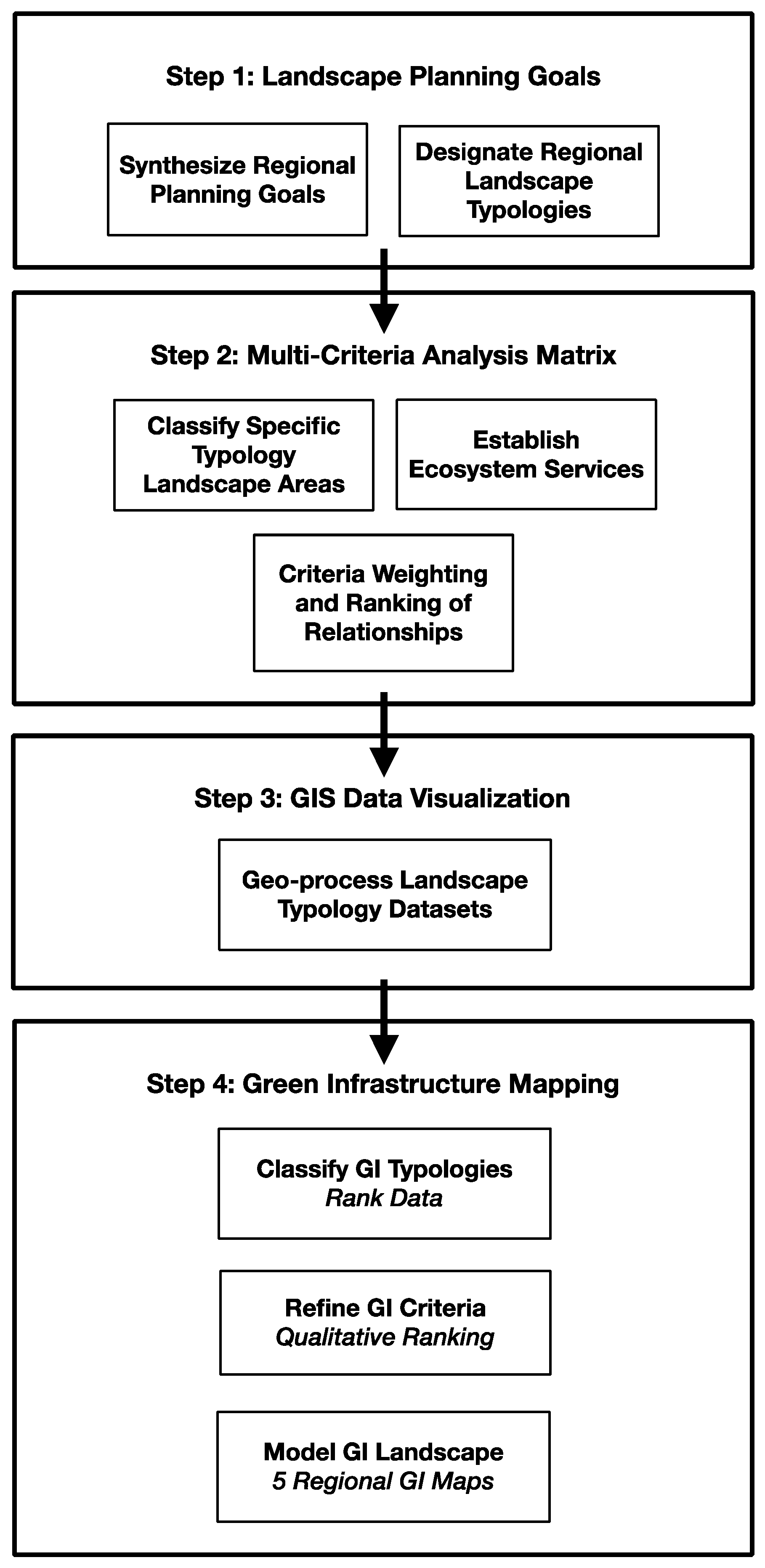
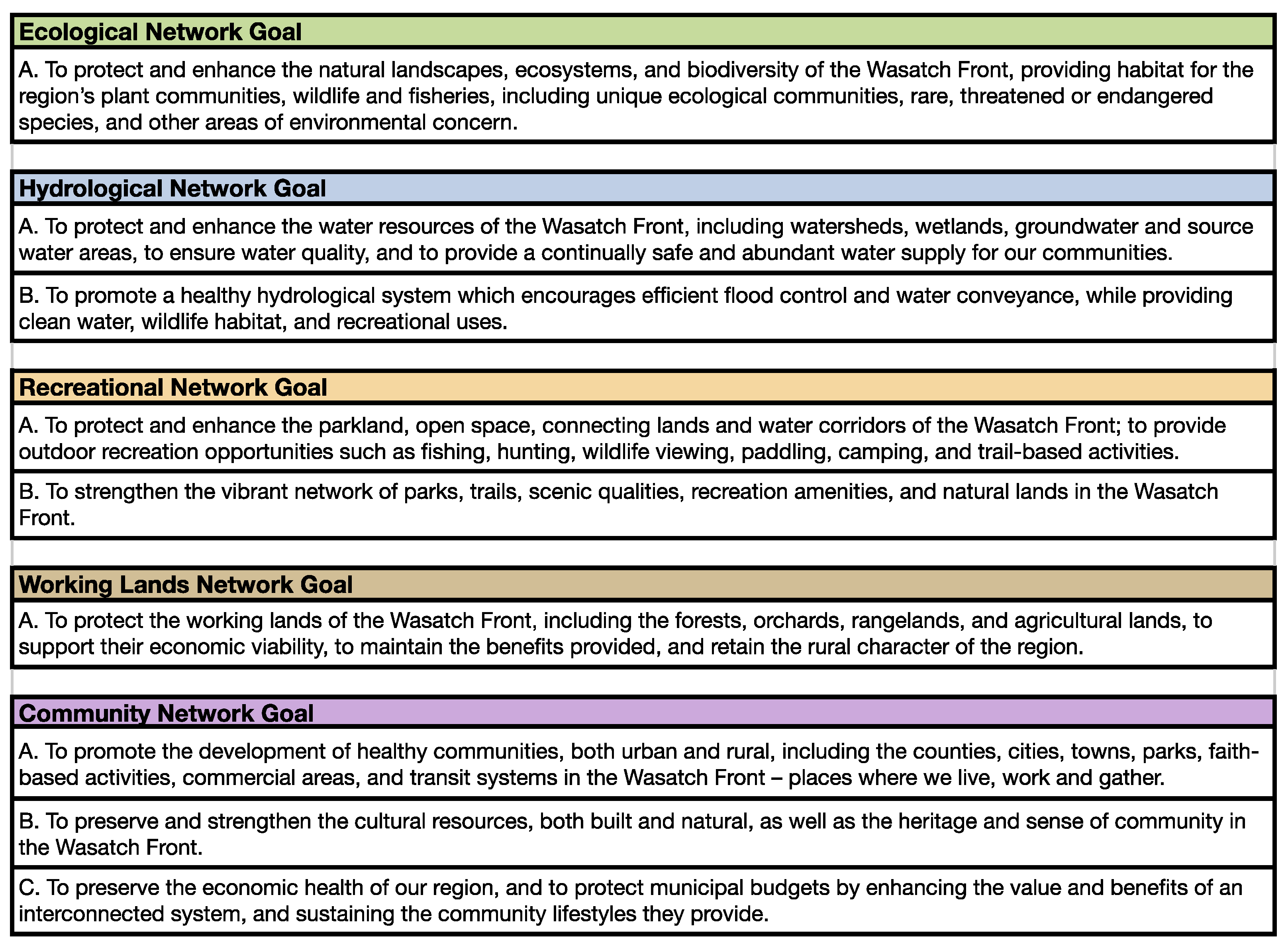
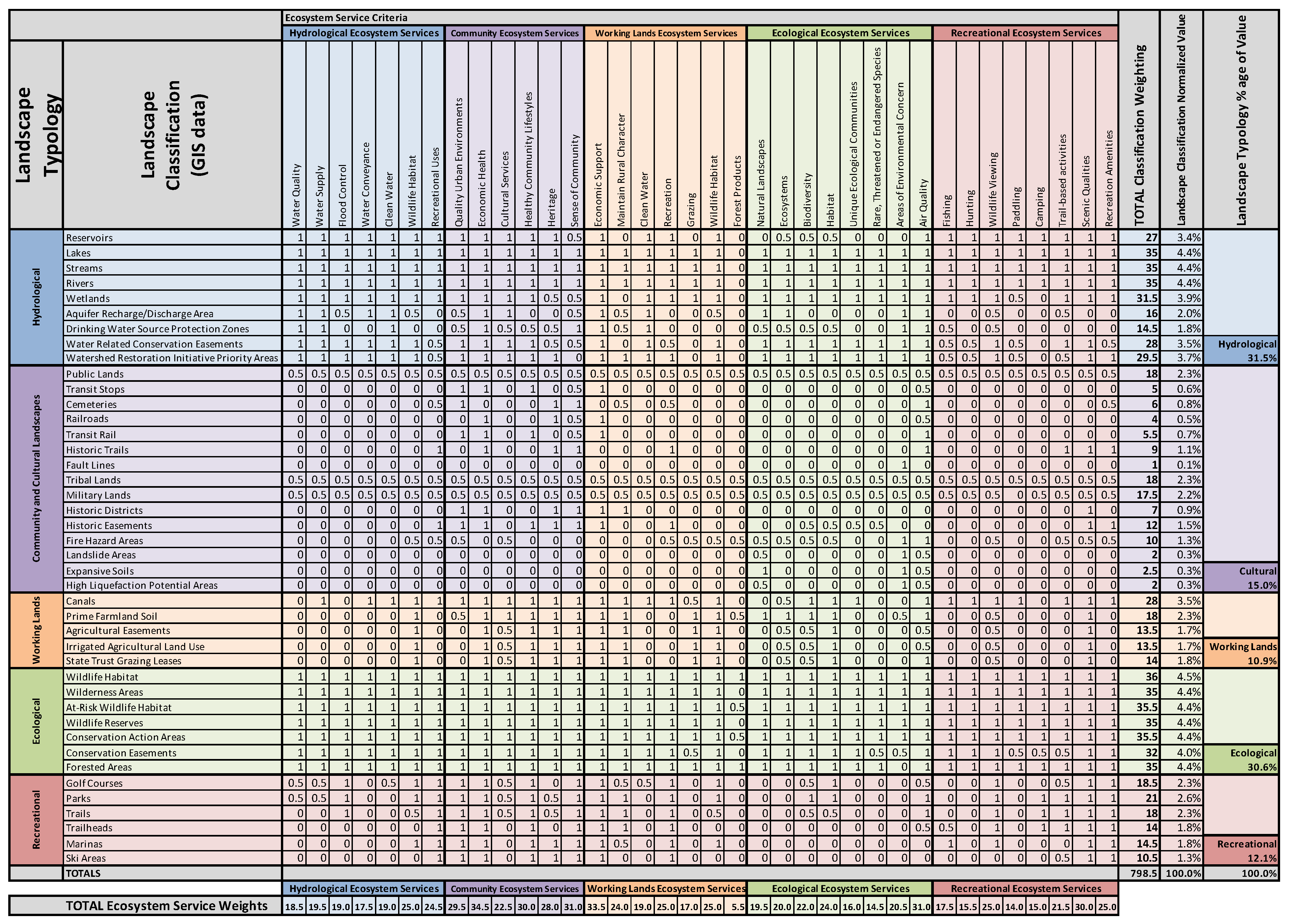
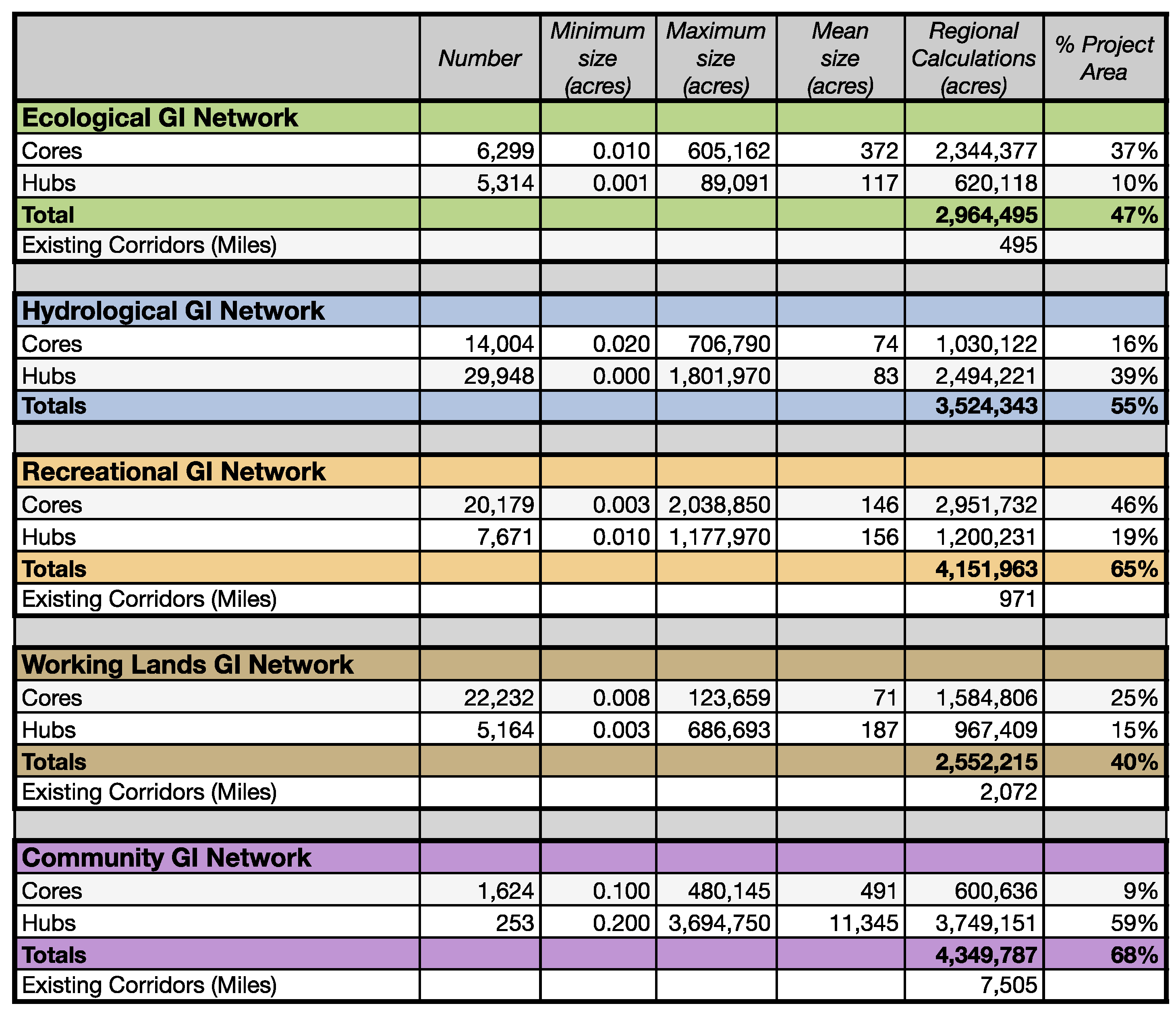
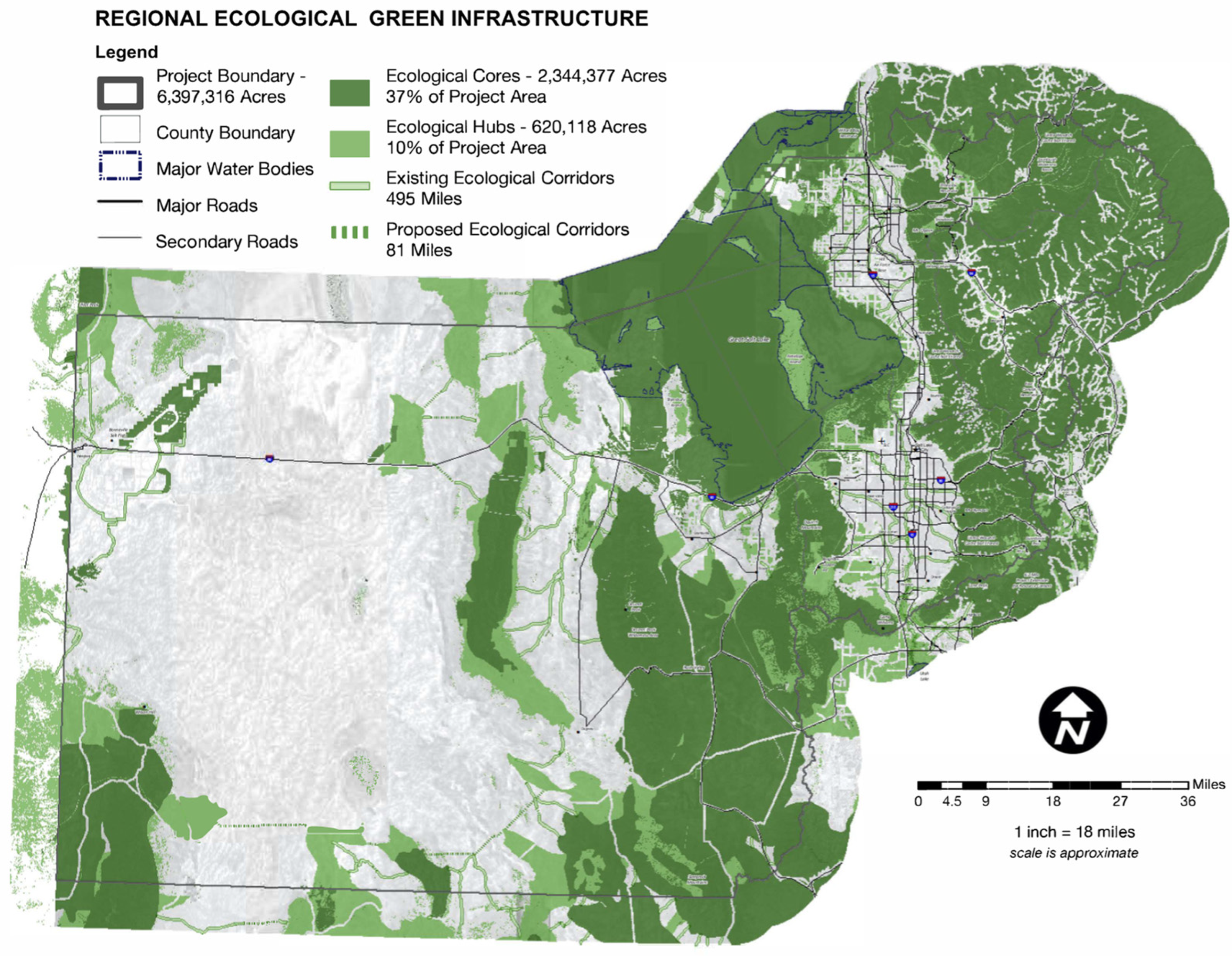
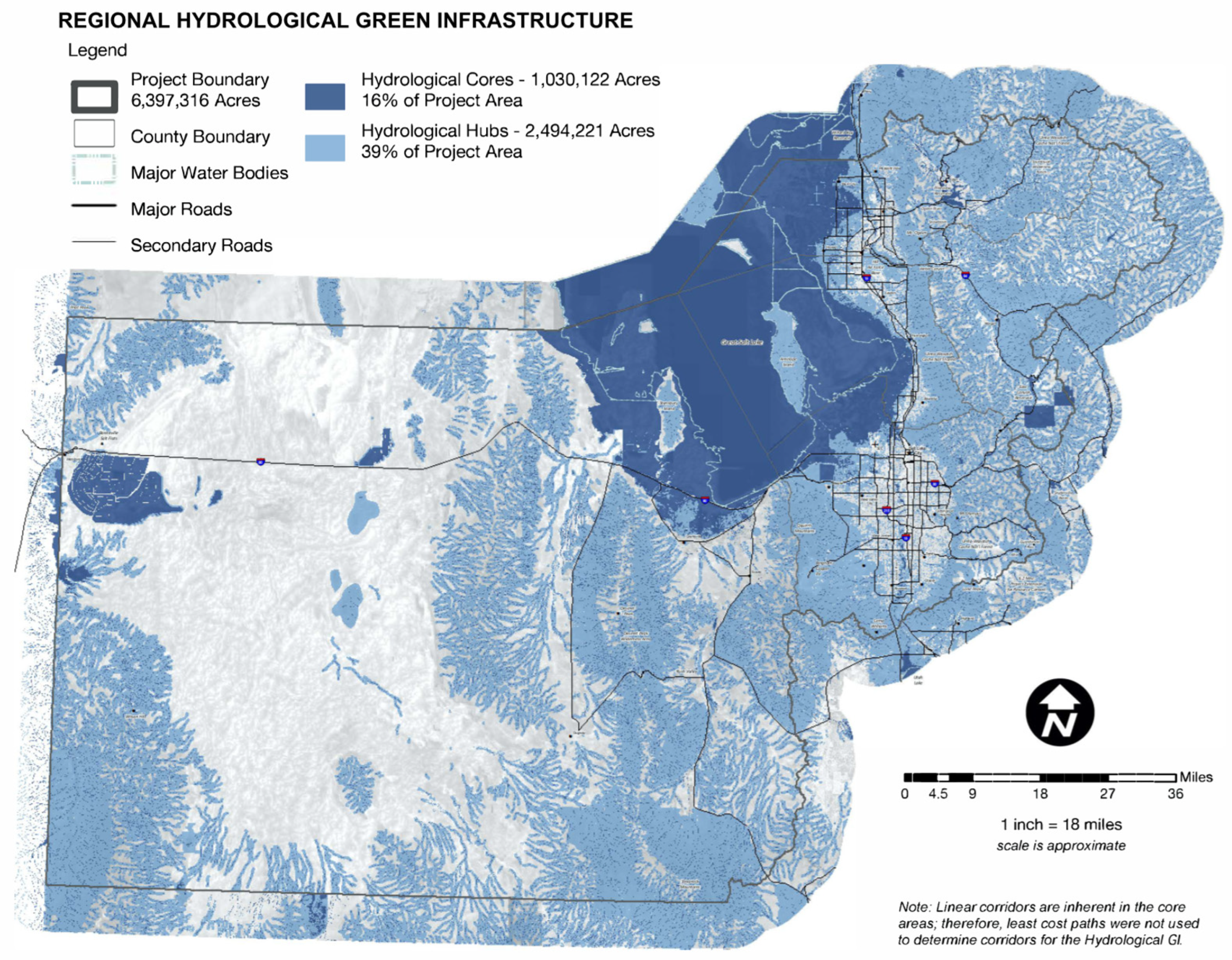
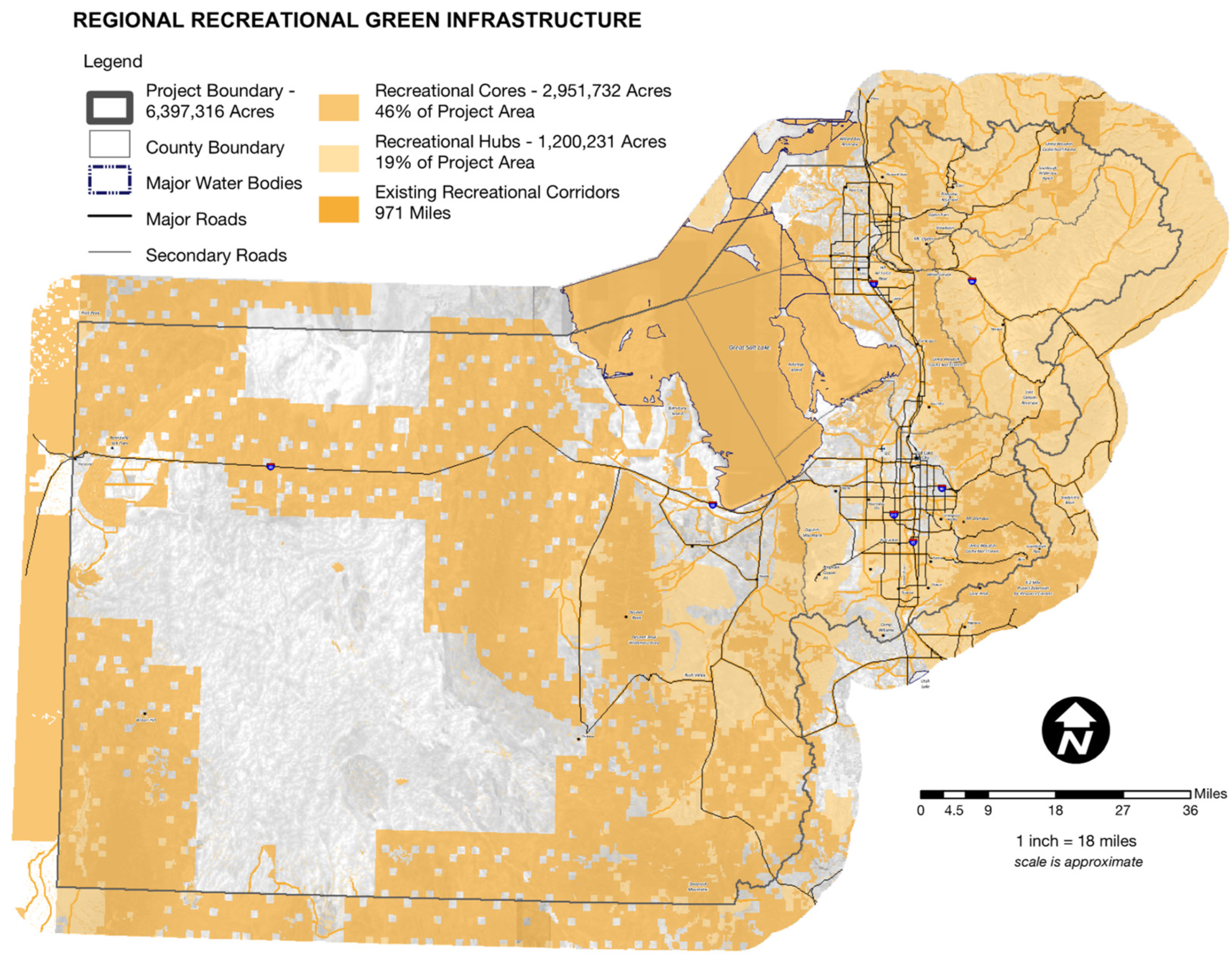
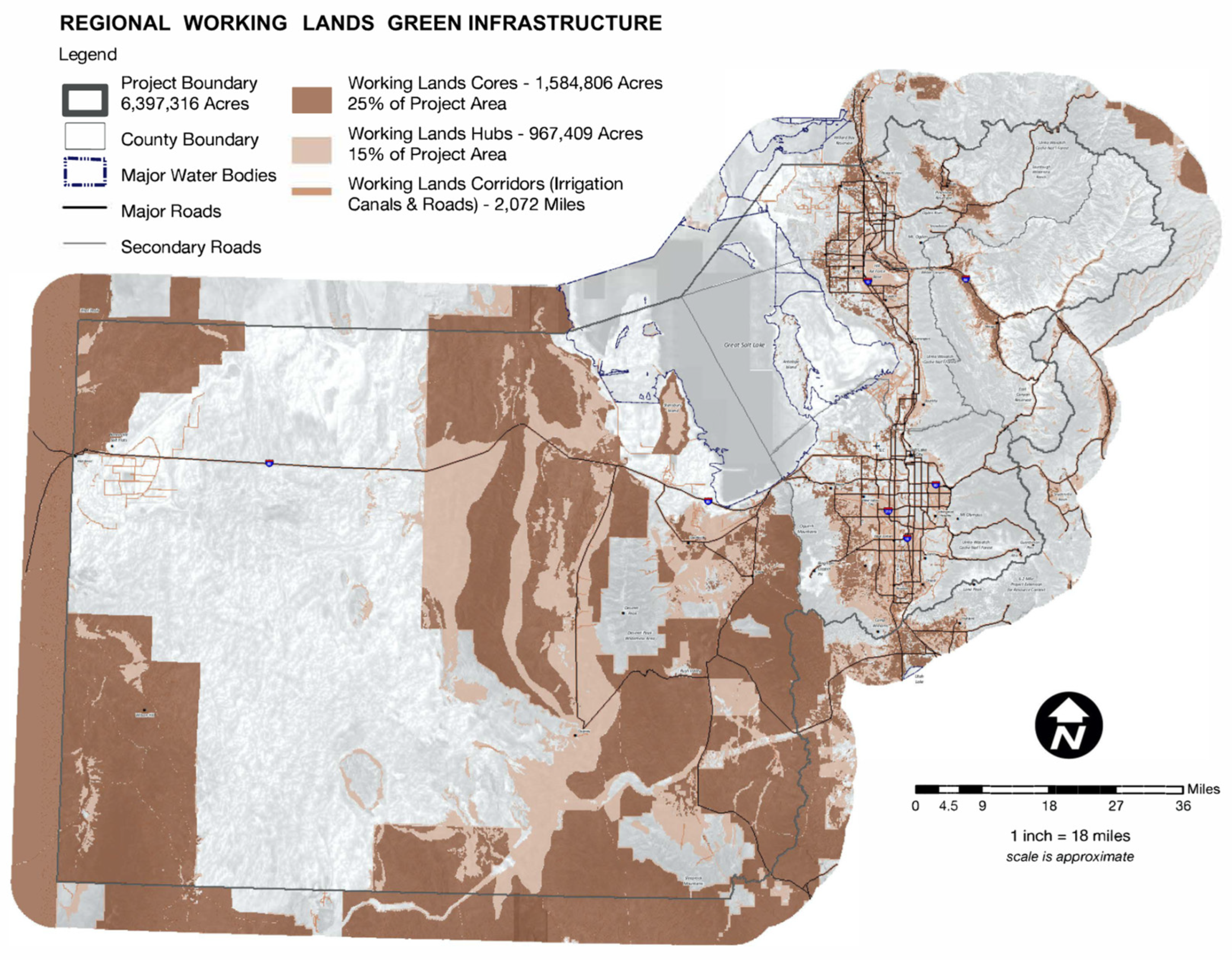
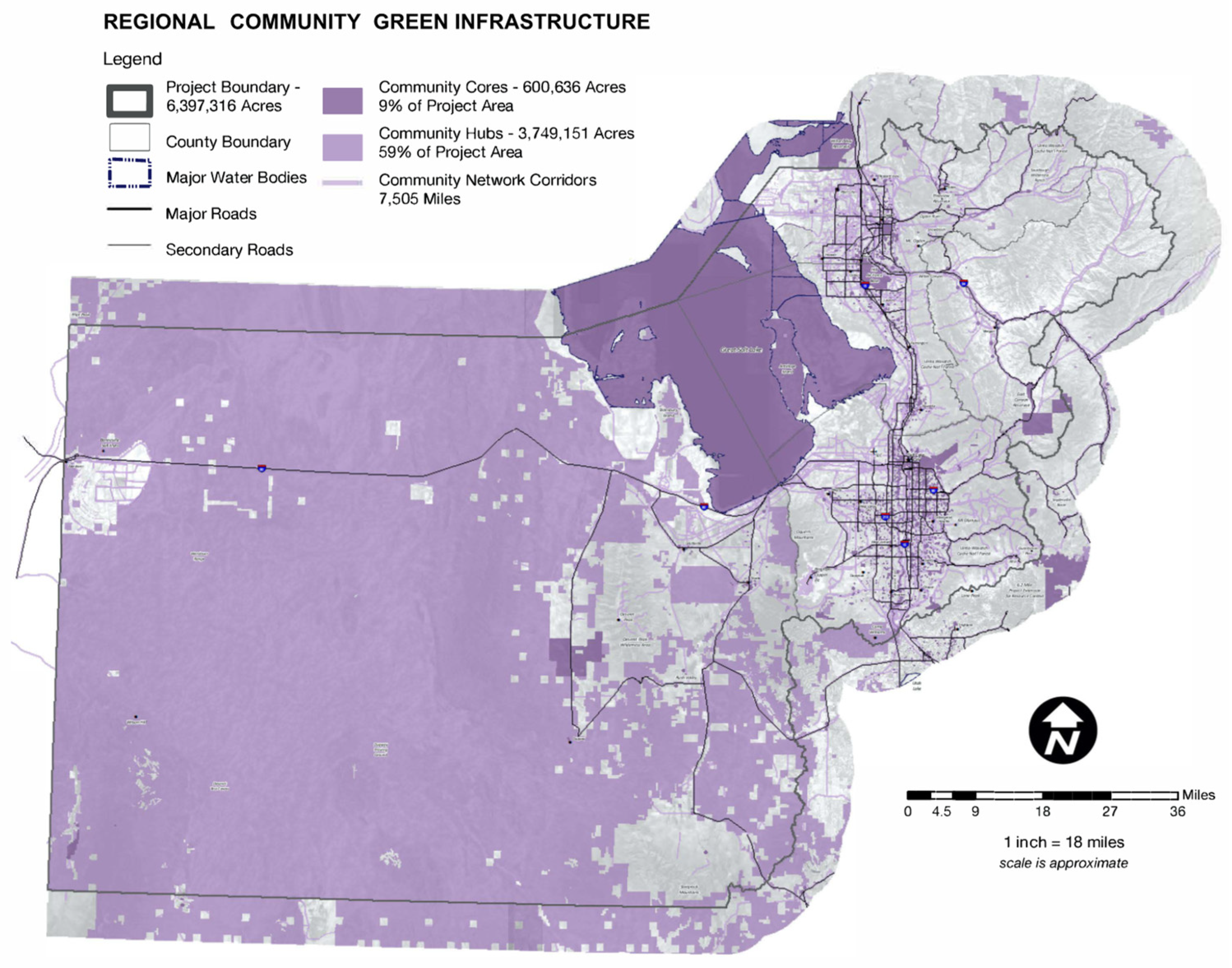
Publisher’s Note: MDPI stays neutral with regard to jurisdictional claims in published maps and institutional affiliations. |
© 2022 by the author. Licensee MDPI, Basel, Switzerland. This article is an open access article distributed under the terms and conditions of the Creative Commons Attribution (CC BY) license (https://creativecommons.org/licenses/by/4.0/).
Share and Cite
leBrasseur, R. Mapping Green Infrastructure Based on Multifunctional Ecosystem Services: A Sustainable Planning Framework for Utah’s Wasatch Front. Sustainability 2022, 14, 825. https://doi.org/10.3390/su14020825
leBrasseur R. Mapping Green Infrastructure Based on Multifunctional Ecosystem Services: A Sustainable Planning Framework for Utah’s Wasatch Front. Sustainability. 2022; 14(2):825. https://doi.org/10.3390/su14020825
Chicago/Turabian StyleleBrasseur, Richard. 2022. "Mapping Green Infrastructure Based on Multifunctional Ecosystem Services: A Sustainable Planning Framework for Utah’s Wasatch Front" Sustainability 14, no. 2: 825. https://doi.org/10.3390/su14020825
APA StyleleBrasseur, R. (2022). Mapping Green Infrastructure Based on Multifunctional Ecosystem Services: A Sustainable Planning Framework for Utah’s Wasatch Front. Sustainability, 14(2), 825. https://doi.org/10.3390/su14020825





